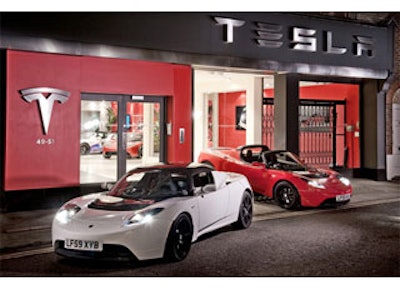
How many electric cars are on the U.S. market today? I can think of the Nissan Leaf, Chevrolet Volt – and, of course – the Tesla Model S. Despite all of these other zero-emission vehicles (that are also a bit more affordable), Tesla always tops this list. Everyone, everywhere, has heard of Tesla. Despite never seeing one in person (though I do admit that the Model S probably isn’t great for Wisconsin driving) – every single person I mention Tesla to knows exactly what I’m talking about. And this is despite a reputation for being too expensive, too inaccessible (lacking a national charging infrastructure – but Tesla is working on that), and did I mention too expensive?
But for those of you looking for your next $62,400+ EV, the Tesla comes with some pretty great stats: The 60 kWh battery option (pricing starts at $62,400 for this battery option) gets an estimated 230 mile range at 55 mph, comes with an eight-year battery warranty, and is available with optional supercharge capabilities. The Model S was also named Motor Trend’s 2012 car of the year. And in 2013, it received Consumer Reports’ top score, scoring 99 out of 100 in the magazine’s battery of tests.
“It accelerates, handles, and brakes like a sports car. It has the ride and quietness of a luxury car and is far more energy-efficient than the best hybrid cars,” Jake Fisher, Consumer Reports’ director of automotive testing, said in a statement. The magazine tested a Model S that cost $89,650 and was equipped with an 85 kWh lithium-ion battery (larger and pricier than the standard 60 kWh battery).
So while other electric car makers are closing their doors – despite U.S. Department of Energy loans for many – Tesla appears to be doing okay. Aptera closed up shop in 2011, laid off 30 employees, and was unable to market a car that could have gotten the equivalent of 190 miles per gallon and sold for less than $30,000, by company estimates. (The DOE said it had not given Aptera any commitment for a loan).
Just last month, CODA filed for bankruptcy protection, after selling just 100 cars. An AP article reported that it had fallen victim to a market that is skeptical of short battery life, high price, and a lack of charging infrastructure.
And in 2013, the Energy Department seized $21 million dollars from Fisker Automotive, which was unable to repay a 2009 loan. The troubled car maker had laid off three quarters of its workers and was continuing to miss milestones set up for the half-a-billion government loan, providing ample signs of its impending failure, according to critics. Fisker continues to struggle.
But Tesla seems be doing just fine. In 2011, CEO Elon Musk vowed to personally pay back the company’s government loan if the company couldn’t. While he promised complete faith that Tesla would have no problem doing so, and also that the company would soon turn a profit – it was an expensive display of confidence. In May of 2013, Tesla fully repaid a $465 million loan from the U.S. government – nine years early.
Continuing to grow and advance the world of EVs, Tesla recently announced “the most advanced charging technology in the world,” according to Musk. This new supercharging option, he says, will allow Model S drivers to travel long distances, for free, indefinitely. He says that the new superchargers will always remain free for Model S drivers. Tesla plans to have superchargers covering 98 percent of the North American population within two years. One pretty effective answer to one doubt that EV skeptics harbor: Short battery life.
And at a recent shareholder’s meeting, Tesla demonstrated another, even quicker option to the charging time conundrum: the fast battery swap. Musk stood onstage as a timer recorded how quickly the Model S batteries can be changed out and compared it to the amount the time filling up a typical sedan’s gas tank: Two battery swaps for every one gas fill-up.
Maybe it’s the problem solving that draws people to Tesla – I don’t know of any other EV maker that is going to the same lengths that Musk is to prove to people that electric really can be the automotive future. Maybe it’s Musk’s dedication and excitement for his own product – he makes promises and, so far, it looks like he’s delivered. Or maybe it’s because the EV is the next great gadget, albeit an expensive one. Either way, Tesla has made sure that it will be a part of the EV landscape for a very long time.
What do you think the future holds for EVs? If I’ve inspired you to go out and buy one today, comment below or email me at [email protected].
Read the response, "Letter To The Editor: OMG...It's A Tesla," here.






















